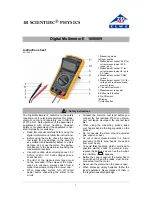
*
Do not input values over the maximum range of each measurement to avoid damages of the
meter.
*
Do not turn the rotary function switch during voltage or current measurement, otherwise the
meter could be damaged.
*
Use caution when working with voltages above 35V DC or 25V AC. These Voltages pose shock
hazard.
*
Replace the battery as soon as the battery indicator “BAT” appears. With a low battery, the
meter might produce false reading that can lead to electric shock and personal injury.
*
Fetch out the battery when the meter will not be used for long period.
*
Periodically wipe the cabinet with a damp cloth and mid detergent. Do not use abrasives or
solvents.
*
The meter is suitable for indoor use only
*
The measurement instrument is not to be unattended.
*
Do not operate the meter before the cabinet has been closed and screwed safely as terminal can
carry voltage.
*
Do not store the meter in a place of explosive, inflammable substances.
*
-
Measuring instruments don’t belong to children hands-
Cleaning the cabinet
Prior to cleaning the cabinet, withdraw the mains plug from the power outlet.
Clean only with a damp, soft cloth and a commercially available mild household cleanser. Ensure
that no water gets inside the equipment to prevent possible shorts and damage to the equipment.
1.1. Table 1; Line inputs
Function
Terminal
Input Limits
V DC
V/
+ COM
600 V DC
V AC
V/
+ COM
600 V AC
Ohm
V/
+ COM
250 V DC/AC
µA/mA DC/AC
µA/mA + COM
250 mA / 250 V
10 A DC/AC
10 A + COM
10 A / 250 V
/ (((
*
)))
V/
+ COM
250 V DC/AC
LOGIC
V/
+ COM
250 V DC/AC
1.2. Safety Symbols
The following symbols are imprinted on the meter’s front panel to remind you of measurement
limitations and safety:
10 A
The maximum current that you can measure at this terminal is 10 amps DC/AC. This
terminal is fuse protected by 10 A/690 V fuse. When using this range with high current,
keep the duty cycle to 30 seconds on load and 15 minutes off load.
mA
The max. current, that you can measure at this terminal is 220 mA DC/AC. This terminal is
fuse protected by 250 mA/690 V fuse.
To avoid electric shock or instrument damage, do not connect the common input COM and
V/
terminal to any source of more than 600 V with respect to earth ground.
-22-
















































